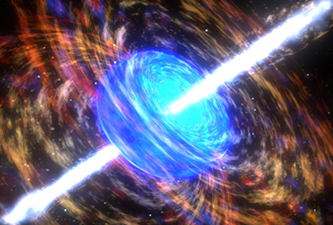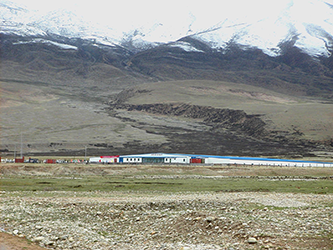Astrophysics

Argo-YBJ: understanding cosmic showers
About once a day, the sky is lit up by a brilliant flash of energy. These gamma-ray bursts – violently energetic eruptions of high-frequency electromagnetic radiation – are caused predominately by the explosion of massive stars in distant galaxies billions of light-years away. Understanding these striking phenomena is data-intensive work and calls for a joint effort between scientists across the world.
A collaboration between Chinese and Italian researchers, the ARGO-YBJ project, observes showers of cosmic rays via detectors situated at high altitude on the Tibet plateau to ensure that the showers are detected without the undue influence of the atmosphere and pollution. These observations produce terabytes of data every year. Previously, data from the telescope had to be recorded on tapes and dispatched to processing centres using buses and planes. With the arrival of the super-fast ORIENTplus link, huge quantities of data can now be transferred continuously and seamlessly to dedicated computing centres in Italy, thus enabling real-time, remote collaboration.
The Challenge
To meet ARGO-YBJ’s mission to improve understanding of cosmic radiation, based on data-intensive collaborative research between astrophysicists in China and Italy.
The Solution
Through its connection to CSTNET (China Science and Technology Network), scientists at the ARGO-YBJ telescope facility in Tibet are able to access the high-speed cross-continental ORIENTplus link and the GÉANT network to continuously and seamlessly transfer huge quantities of data in real-time to INFN-CNAF, a dedicated computing centre for high-energy physics experiments in Bologna, Italy, connected to GARR, the Italian research network.
Key Benefits
The power of ORIENTplus has been harnessed as an essential element in enabling a cutting-edge international scientific collaboration between physicists in a remote Tibetan location and in Italy, aimed to provide insights into the mysteries of the universe.
“The only places in the world where we can site the telescope are remote and difficult to work in. So we need to be able to transfer terabytes of data every year from the telescope to the processing centre in Italy for analysis and study. It used to be that the only way of doing this was to get our scientists to fly to Italy with suitcases full of data tapes – hardly cutting edge science! Stable, high-capacity networks are therefore absolutely fundamental to our success. ORIENTplus fits the bill and is, frankly, a godsend. Without it, carrying out this research would be nothing more than a scientist’s pipe-dream. We have recently upgraded the telescope and we are now producing outgoing traffic that peaks at over 100 Mbps – and it looks like we are going to be making even higher demands on ORIENTplus in the future.”
Professor Benedetto D’Ettorre Piazzoli, Italian spokesman of the ARGO-YBJ collaboration
Read the full version of the case study – English version (PDF) *
Read the full version of the case study – Chinese version (PDF)
*Produced in 2012 during the ORIENTplus project


Artist’s impression of gamma-ray burst (©NASA/SkyWorks Digital)

Cutting-edge science on top of the world

